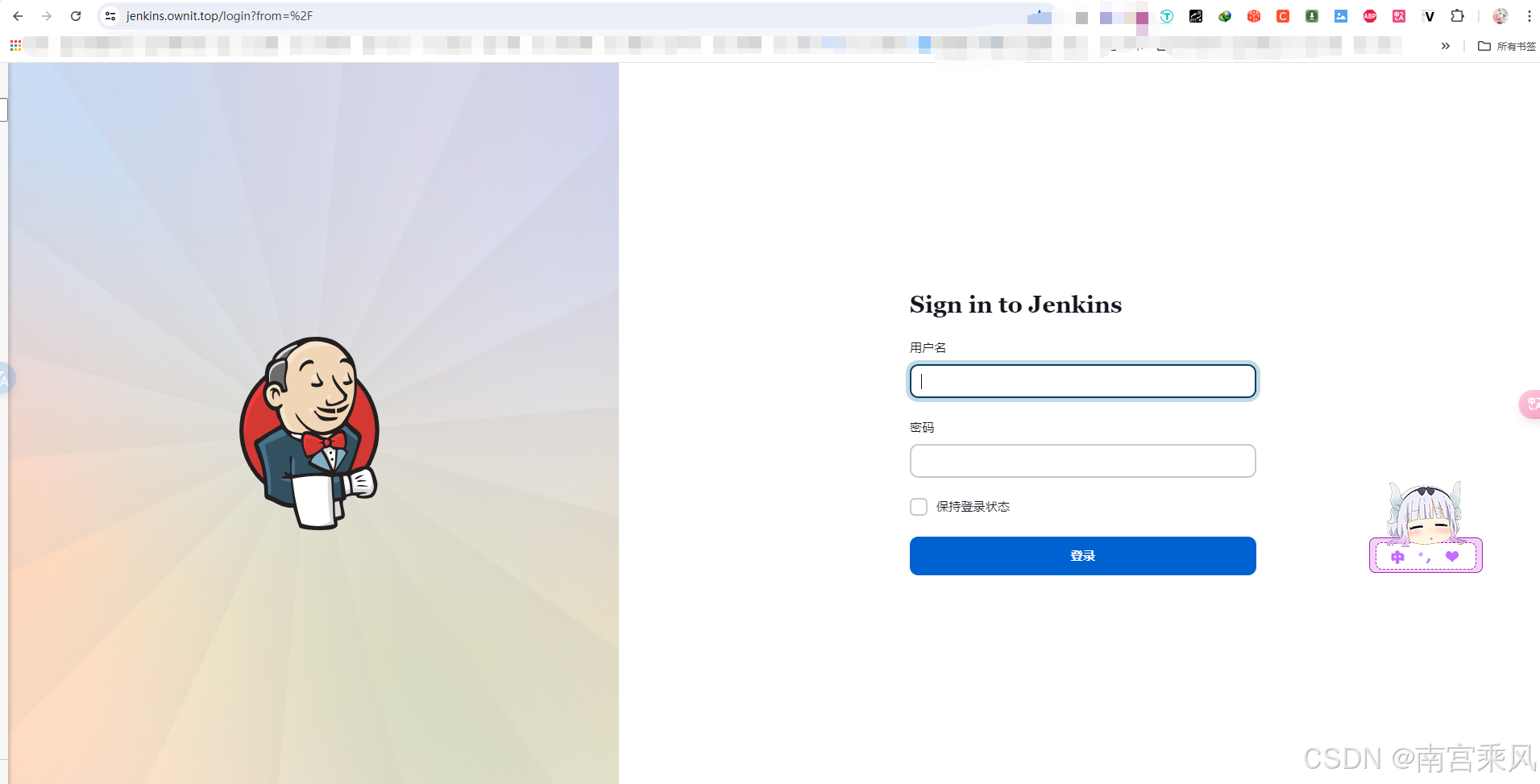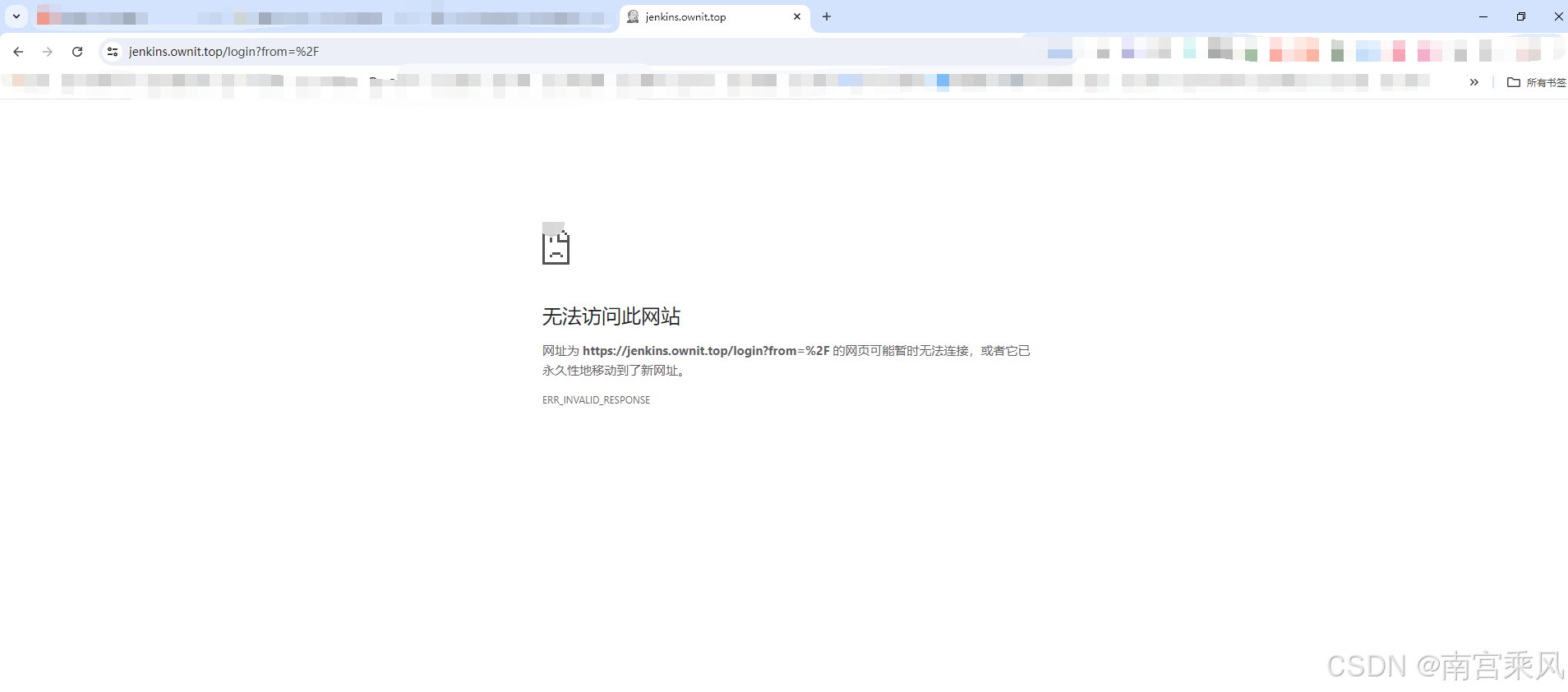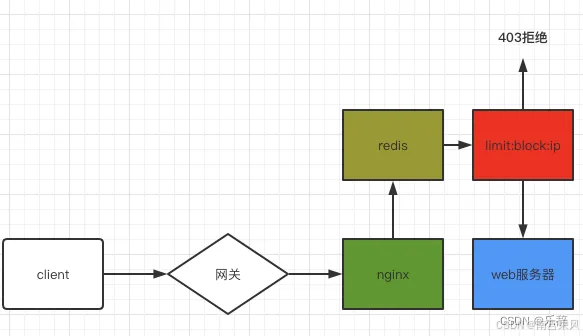1、引言
在当今数字化时代,网络安全已成为企业和个人用户关注的焦点。IP黑白名单作为一种有效的网络安全策略,允许我们精确控制对Web资源的访问权限。通过白名单,我们可以确保只有可信的IP地址能够访问敏感资源;而黑名单则可以阻止恶意IP的访问,从而减少安全风险。
选择Nginx OpenResty与Redis作为实现黑白名单的解决方案,是基于以下几个原因:
- 高性能:Nginx以其轻量级和高性能著称,适合处理高并发请求。
- 灵活性:OpenResty通过集成Lua脚本,提供了强大的定制能力。
- 可扩展性:Redis作为一个内存数据结构存储,支持数据的快速读写,适合实现动态的黑白名单管理。
2、简介
1、什么是OpenResty?
OpenResty是一个基于Nginx的全功能Web平台,它集成了一系列精心设计的Lua库、第三方模块和一个基于LuaJIT的轻量级Web框架。OpenResty的核心是Nginx,但它通过Lua语言扩展了Nginx的功能,使其能够构建能够处理超高并发的动态Web应用。
2、OpenResty与Nginx的关系
OpenResty是在Nginx的基础上构建的,它保留了Nginx的所有功能,并通过Lua语言扩展了其能力。这意味着你可以使用OpenResty来实现Nginx的所有功能,同时还能够利用Lua脚本来实现更复杂的业务逻辑。
3、环境安装
1、环境版本
1
2
3
|
centos 7
redis 7.2
nginx version: openresty/1.25.3.1
|
2、环境安装
1、添加OpenResty仓库
1
2
3
4
5
|
# 由于公共库中找不到openresty,所以需要添加openresty的源仓库
yum-config-manager --add-repo https://openresty.org/package/centos/openresty.repo
# 注意,如果上面命令提示不存在,那就先安装一下
yum install -y yum-utils
|
- 安装OpenResty
1
2
3
4
|
# 安装openresty
yum install -y openresty
# 安装OpenResty管理工具,帮助我们安装第三方的Lua模块
yum install -y openresty-opm
|
3、目录结构
默认安装在/usr/local/openresty
 看到里面有一个nginx目录,进去可以看到跟我们平常用的nginx是一模一样的,OpenResty就是在Nginx基础上集成了一些Lua模块
看到里面有一个nginx目录,进去可以看到跟我们平常用的nginx是一模一样的,OpenResty就是在Nginx基础上集成了一些Lua模块
到这里我们就安装好了
4、启动和运行
OpenResty底层是基于Nginx的,查看OpenResty目录的nginx目录,结构与windows中安装的nginx基本一致
5、安装配置redis
1
|
sudo yum install redis -y
|
Redis配置主要包括设置持久化选项、网络配置、安全性设置等。以下是一个基本的配置示例:
1
2
3
4
5
|
# redis.conf
port 6379
bind 127.0.0.1
protected-mode yes
requirepass "yourpassword"
|
4、白名单实现

图例说明:
- 客户端:发送HTTP请求的用户或应用。
- Nginx (OpenResty):处理和管理HTTP请求,执行Lua脚本进行访问控制。
- Lua脚本:在Nginx中运行,负责从Redis获取白名单并进行IP检查。
- Redis:存储白名单数据,用于快速查询。
交互流程:
- 客户端发送请求到Nginx。
- Nginx调用Lua脚本进行访问控制。
- Lua脚本连接Redis,并查询IP是否在白名单中。
- Lua脚本返回查询结果给Nginx。
- Nginx根据结果决定是否允许请求,并返回响应给客户端
定义白名单的作用与重要性
白名单是一种安全策略,用于定义一组被信任的IP地址或实体,它们被允许访问特定的资源或服务。在Web应用中,白名单的作用尤为显著:
- 安全性增强:限制访问权限,仅允许特定的IP地址访问敏感资源。
- 防止滥用:减少恶意用户或爬虫对服务的滥用。
- 流量管理:通过控制访问源,更有效地管理网络流量。
通过OpenResty Lua脚本实现白名单逻辑
在OpenResty中,我们可以使用Lua脚本来实现白名单逻辑。Lua脚本可以在Nginx的配置文件中直接编写,或者存储在外部文件中,并在配置文件中引用。
Lua脚本实现步骤:
- 定义白名单:在Redis中存储白名单IP地址。
- 访问控制:在Nginx配置中使用
access_by_lua_block或access_by_lua_file指令调用Lua脚本。
- 脚本逻辑:检查请求的IP地址是否在白名单中,如果不在,则拒绝访问。
案例演示
jenkins.ownit.top.conf
这个是nginx的配置文件
最主要内容:access_by_lua_file /opt/nginx/lua_script/white.lua;
1
2
3
4
5
6
7
8
9
10
11
12
13
14
15
16
17
18
19
20
21
22
23
24
25
26
27
28
29
30
31
32
33
34
35
36
37
|
upstream jenkins-uat {
server 192.168.102.20:91;
}
server {
listen 80;
server_name jenkins.ownit.top;
#白名单 或者 黑名单
#include /opt/nginx/whitelist/corporation.conf;
location / {
rewrite ^/(.*)$ https://$host/$1 permanent;
}
access_log /www/wwwlogs/dns.ownit.top.log;
error_log /www/wwwlogs/dns.ownit.top.error.log;
}
server {
listen 443 ssl;
server_name jenkins.ownit.top;
#白名单 或者 黑名单
#include /opt/nginx/whitelist/corporation.conf;
#ssl on;
ssl_certificate /opt/nginx/ssl/ownit.top.crt;
ssl_certificate_key /opt/nginx/ssl/ownit.top.key;
include ssl.conf;
location / {
access_by_lua_file /opt/nginx/lua_script/white.lua; # nginx的lua脚本
proxy_pass http://jenkins-uat;
include https_proxy.conf;
}
access_log /www/wwwlogs/dns.ownit.top.log;
error_log /www/wwwlogs/dns.ownit.top.error.log;
}
|
white.lua文件
通过使用Lua脚本,在接收到HTTP请求时检查请求的IP地址是否在Redis存储的白名单中。如果IP不在白名单中,则拒绝访问。
思路
- 获取客户端IP和请求路径:在Lua脚本中获取客户端的IP地址和请求路径。
- 连接Redis:使用
resty.redis模块连接Redis数据库。
- 权限校验:对连接的Redis进行认证。
- 检查IP是否在白名单中:从Redis中检查IP是否存在于白名单集合中。
- 返回结果:如果IP在白名单中,允许访问;否则,返回403 Forbidden状态码,拒绝访问。
- 释放Redis连接:将Redis连接返回到连接池中,以便复用。
1
2
3
4
5
6
7
8
9
10
11
12
13
14
15
16
17
18
19
20
21
22
23
24
25
26
27
28
29
30
31
32
33
34
35
36
37
38
39
|
-- 获取客户端IP和请求路径
local client_ip = ngx.var.remote_addr
local path = ngx.var.uri
-- Redis相关配置
local redis_key_white_list = "map_request_white_list"
-- 连接Redis
local redis = require "resty.redis"
local red = redis:new()
red:set_timeout(1000) -- 设置超时(毫秒)
local ok, err = red:connect("127.0.0.1", 6379)
if not ok then
ngx.log(ngx.ERR, "Redis连接失败: ", err)
return ngx.exit(500)
end
-- 权限校验
local res, err = red:auth("123456")
if not res then
ngx.say("failed to authenticate: ", err)
return
end
-- 检查IP是否在白名单中
local is_in_whitelist, err = red:sismember(redis_key_white_list, client_ip)
if is_in_whitelist == 1 then
ngx.log(ngx.INFO, "IP在白名单中: ", client_ip)
else
ngx.status = ngx.HTTP_FORBIDDEN
ngx.say("Access Denied")
return ngx.exit(ngx.HTTP_FORBIDDEN)
end
-- 返还redis连接到连接池
local ok, err = red:set_keepalive(10000, 100)
if not ok then
ngx.log(ngx.ERR, "设置keepalive失败: ", err)
end
|
详细解释
-
获取客户端IP和请求路径
1
2
|
local client_ip = ngx.var.remote_addr
local path = ngx.var.uri
|
这两行代码从Nginx变量中获取客户端的IP地址和请求路径,client_ip用于后续的白名单检查。
-
Redis相关配置
1
|
local redis_key_white_list = "map_request_white_list"
|
定义存储白名单的Redis键。
-
连接Redis
1
2
3
4
5
6
7
8
|
local redis = require "resty.redis"
local red = redis:new()
red:set_timeout(1000) -- 设置超时(毫秒)
local ok, err = red:connect("127.0.0.1", 6379)
if not ok then
ngx.log(ngx.ERR, "Redis连接失败: ", err)
return ngx.exit(500)
end
|
使用resty.redis模块创建Redis连接对象,并设置连接超时时间。尝试连接到Redis服务器,如果连接失败,记录错误日志并返回500错误。
-
权限校验
1
2
3
4
5
|
local res, err = red:auth("123456")
if not res then
ngx.say("failed to authenticate: ", err)
return
end
|
对Redis进行认证,如果认证失败,输出错误信息并停止执行。
- 检查IP是否在白名单中
1
2
3
4
5
6
7
8
|
local is_in_whitelist, err = red:sismember(redis_key_white_list, client_ip)
if is_in_whitelist == 1 then
ngx.log(ngx.INFO, "IP在白名单中: ", client_ip)
else
ngx.status = ngx.HTTP_FORBIDDEN
ngx.say("Access Denied")
return ngx.exit(ngx.HTTP_FORBIDDEN)
end
|
使用SISMEMBER命令检查IP是否在Redis的白名单集合中。如果IP在白名单中,记录信息日志;否则,返回403 Forbidden状态码并拒绝访问。
- 释放Redis连接
1
2
3
4
|
local ok, err = red:set_keepalive(10000, 100)
if not ok then
ngx.log(ngx.ERR, "设置keepalive失败: ", err)
end
|
将Redis连接返回到连接池中,以便后续请求复用该连接。如果设置失败,记录错误日志。
在Nginx中配置Lua脚本
在Nginx的location配置中,使用access_by_lua_file指令来调用上述Lua脚本:
1
2
3
4
5
6
7
8
9
10
11
12
13
14
|
http {
```lua
http {
server {
listen 80;
server_name example.com;
location / {
access_by_lua_file /opt/nginx/lua_script/white.lua;
proxy_pass http://backend;
}
}
}
|
上述配置在接收到HTTP请求时,会首先执行/opt/nginx/lua_script/white.lua脚本进行白名单检查。如果通过检查,则继续将请求转发到后端服务器。
 成功访问:
成功访问:
 禁止访问:
禁止访问:

5、黑名单实现
黑名单的作用与场景
黑名单是一种网络安全机制,用于识别并阻止恶意IP地址对服务器资源的访问。它在多种场景中发挥着重要作用:
- 防止恶意攻击:通过封禁已知的攻击者IP,减少服务器遭受的恶意攻击。
- 打击爬虫滥用:限制爬虫对网站资源的过度访问,保护数据不被滥用。
- 减轻服务器负载:通过限制特定IP的访问频率,减轻服务器压力,提高服务稳定性。
- DDoS防御:快速响应DDoS攻击,封禁攻击源IP,保护服务可用性。
使用Lua脚本与Redis实现动态IP封禁
OpenResty结合Redis可以实现一个高效的动态IP封禁系统。以下是实现的关键步骤:
- 环境配置:确保Nginx OpenResty和Redis环境准备就绪。
- Lua脚本编写:编写Lua脚本来动态查询和更新Redis中的黑名单状态。
- Nginx配置整合:在Nginx配置文件中集成Lua脚本,实现访问控制。

案例演示
通过使用Lua脚本,在接收到HTTP请求时检查请求的IP地址是否在黑名单中,或控制IP的访问频率,并进行相应的处理。
思路
- 获取客户端IP:在Lua脚本中获取客户端的IP地址。
- 连接Redis:使用
resty.redis模块连接Redis数据库。
- 权限校验:对连接的Redis进行认证。
- 检查IP是否在黑名单中:从Redis中检查IP是否存在于黑名单集合中。
- 访问频次控制:对每个IP的访问频次进行限制,如果超过指定的频次,则将IP加入黑名单。
- 返回结果:如果IP在黑名单中,返回403 Forbidden状态码,拒绝访问;否则,允许请求继续。
Nginx 配置文件
1
2
3
4
5
6
7
8
9
10
11
12
13
14
15
16
17
18
19
20
21
22
23
24
25
26
27
28
29
30
31
32
33
34
35
36
37
38
39
40
41
|
upstream jms-uat {
server 192.168.82.105:81;
}
server {
listen 80;
server_name jms.ownit.top;
# 白名单 或者 黑名单
# include /opt/nginx/whitelist/corporation.conf;
rewrite ^/(.*)$ https://$host/$1 permanent;
access_log /www/wwwlogs/dns.ownit.top.log;
error_log /www/wwwlogs/dns.ownit.top.error.log;
}
server {
listen 443 ssl;
server_name jms.ownit.top;
# 白名单 或者 黑名单
# include /opt/nginx/whitelist/corporation.conf;
ssl_certificate /opt/nginx/ssl/ownit.top.crt;
ssl_certificate_key /opt/nginx/ssl/ownit.top.key;
include ssl.conf;
location = /core/auth/login/ {
access_by_lua_file /opt/nginx/lua_script/login.lua;
proxy_pass http://jms-uat;
proxy_set_header Upgrade $http_upgrade;
proxy_set_header Connection "upgrade";
}
location / {
if ($request_uri !~ \.(html|htm|jpg|png|ico|js|css)$) {
access_by_lua_file /opt/nginx/lua_script/rule.lua;
}
proxy_set_header Upgrade $http_upgrade;
proxy_set_header Connection "upgrade";
proxy_pass http://jms-uat;
include https_proxy.conf;
client_max_body_size 0;
}
access_log /www/wwwlogs/dns.ownit.top.log;
error_log /www/wwwlogs/dns.ownit.top.error.log;
}
|
location = /core/auth/login/
1
2
3
4
5
6
|
location = /core/auth/login/ {
access_by_lua_file /opt/nginx/lua_script/login.lua;
proxy_pass http://jms-uat;
proxy_set_header Upgrade $http_upgrade;
proxy_set_header Connection "upgrade";
}
|
解释
location = /core/auth/login/:
- 这是一个精确匹配的
location块,仅对请求路径严格等于/core/auth/login/的请求生效。
access_by_lua_file /opt/nginx/lua_script/login.lua;:
- 使用OpenResty的Lua模块,指定在访问控制阶段执行
/opt/nginx/lua_script/login.lua脚本。这个脚本通常用于执行认证、权限检查或其他预处理逻辑。
proxy_pass http://jms-uat;:
- 将匹配到的请求代理到上游服务器
http://jms-uat。
proxy_set_header Upgrade $http_upgrade;:
- 设置
Upgrade请求头,支持WebSocket等协议升级。$http_upgrade变量包含原始请求中的Upgrade头字段的值。
proxy_set_header Connection "upgrade";:
- 设置
Connection请求头为upgrade,通常与Upgrade头一起使用,以确保连接升级。
location /
1
2
3
4
5
6
7
8
9
10
11
|
location / {
# 如果该location 下存在静态资源文件可以做一个判断
if ($request_uri !~ \.(html|htm|jpg|png|ico|js|css)$) {
access_by_lua_file /opt/nginx/lua_script/rule.lua; 加上了这条配置,则会根据 rule.lua 的规则进行限流
}
proxy_set_header Upgrade $http_upgrade;
proxy_set_header Connection "upgrade";
proxy_pass http://jms-uat;
include https_proxy.conf;
client_max_body_size 0;
}
|
解释
location /:
- 这是一个通配符匹配的
location块,表示所有路径的请求都会匹配到这个块,除非有其他更精确的匹配块。
if ($request_uri !~ \.(html|htm|jpg|png|ico|js|css)$):
- 使用
if指令对请求路径进行检查。仅在请求路径不匹配指定的静态资源文件扩展名(如.html, .htm, .jpg, .png, .ico, .js, .css)时,执行后续的Lua脚本。这种检查有助于将动态资源与静态资源区分开来。
access_by_lua_file /opt/nginx/lua_script/rule.lua;:
- 使用OpenResty的Lua模块,指定在访问控制阶段执行
/opt/nginx/lua_script/rule.lua脚本。这个脚本通常用于实现限流、防火墙或其他动态访问控制逻辑。
proxy_set_header Upgrade $http_upgrade;:
- 设置
Upgrade请求头,支持WebSocket等协议升级。$http_upgrade变量包含原始请求中的Upgrade头字段的值。
proxy_set_header Connection "upgrade";:
- 设置
Connection请求头为upgrade,通常与Upgrade头一起使用,以确保连接升级。
proxy_pass http://jms-uat;:
- 将匹配到的请求代理到上游服务器
http://jms-uat。
include https_proxy.conf;:
- 包含额外的配置文件
https_proxy.conf,该文件可能包含HTTPS代理相关的其他配置项。
client_max_body_size 0;:
- 设置客户端请求体的最大大小为0,表示不限制请求体的大小。
这两个location块主要用于处理不同路径的请求,并在访问控制阶段使用Lua脚本进行相应的逻辑处理。精确匹配的/core/auth/login/路径专用于特定的认证或预处理,而通配符匹配的/路径则处理所有其他请求,并进行动态访问控制逻辑。两者共同确保了Nginx服务器的灵活性和安全性。
Lua脚本 (rule.lua)
1
2
3
4
5
6
7
8
9
10
11
12
13
14
15
16
17
18
19
20
21
22
23
24
25
26
27
28
29
30
31
32
33
34
35
36
37
38
39
40
41
42
43
44
45
46
47
48
49
50
51
52
53
54
55
56
57
58
59
60
61
62
63
64
65
66
67
68
69
70
71
72
73
74
75
76
77
78
79
80
81
82
83
84
85
86
87
88
89
90
91
92
93
94
95
96
|
-- 连接池超时回收毫秒
local pool_max_idle_time = 10000
-- 连接池大小
local pool_size = 100
-- redis 连接超时时间
local redis_connection_timeout = 100
-- redis host
local redis_host = "192.168.102.20"
-- redis port
local redis_port = "6379"
-- redis auth
local redis_auth = "123456"
-- 封禁IP时间(秒)
local ip_block_time = 120
-- 指定ip访问频率时间段(秒)
local ip_time_out = 10
-- 指定ip访问频率计数最大值(次)
local ip_max_count = 60
-- 错误日志记录
local function errlog(msg, ex)
ngx.log(ngx.ERR, msg, ex)
end
-- 释放连接池
local function close_redis(red)
if not red then
return
end
local ok, err = red:set_keepalive(pool_max_idle_time, pool_size)
if not ok then
ngx.say("redis connct err:", err)
return red:close()
end
end
-- 连接redis
local redis = require "resty.redis"
local client = redis:new()
local ok, err = client:connect(redis_host, redis_port)
-- 连接失败返回服务器错误
if not ok then
return
end
-- 设置超时时间
client:set_timeout(redis_connection_timeout)
-- 优化验证密码操作
local connCount, err = client:get_reused_times()
-- 新建连接,需要认证密码
if 0 == connCount then
local ok, err = client:auth(redis_auth)
if not ok then
errlog("failed to auth: ", err)
return
end
elseif err then
errlog("failed to get reused times: ", err)
return
end
-- 获取请求ip
local function getIp()
local clientIP = ngx.req.get_headers()["X-Real-IP"]
if clientIP == nil then
clientIP = ngx.req.get_headers()["x_forwarded_for"]
end
if clientIP == nil then
clientIP = ngx.var.remote_addr
end
return clientIP
end
local clientIp = getIp()
local incrKey = "limit:all:count:" .. clientIp
local blockKey = "limit:all:block:" .. clientIp
-- 查询ip是否被禁止访问,如果存在则返回403错误代码
local is_block, err = client:get(blockKey)
if tonumber(is_block) == 1 then
ngx.exit(ngx.HTTP_FORBIDDEN)
close_redis(client)
end
local ip_count, err = client:incr(incrKey)
if tonumber(ip_count) == 1 then
client:expire(incrKey, ip_time_out)
end
-- 如果超过单位时间限制的访问次数,则添加限制访问标识,限制时间为ip_block_time
if tonumber(ip_count) > tonumber(ip_max_count) then
client:set(blockKey, 1)
client:expire(blockKey, ip_block_time)
end
close_redis(client)
|
 成功访问:
成功访问:

失败访问:

参考文档:
https://www.cnblogs.com/KingArmy/p/18019489
https://blog.csdn.net/qq_45503196/article/details/134648292
 看到里面有一个nginx目录,进去可以看到跟我们平常用的nginx是一模一样的,OpenResty就是在Nginx基础上集成了一些Lua模块
看到里面有一个nginx目录,进去可以看到跟我们平常用的nginx是一模一样的,OpenResty就是在Nginx基础上集成了一些Lua模块
 成功访问:
成功访问:
 禁止访问:
禁止访问:


 成功访问:
成功访问:


